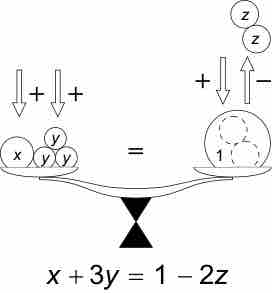Equations
An equation is a mathematical statement that asserts the equality of two expressions. This is written by placing the expressions on either side of an equals sign (=), for example:
asserts that

Equation as a Balance
Illustration of a simple equation as a balance.
Equations often express relationships between given quantities—the knowns—and quantities yet to be determined—the unknowns. By convention, unknowns are denoted by letters at the end of the alphabet (
Inequalities
An inequality is a relation that holds between two values when they are different. The notation
In either case,
- The notation
$a < b$ means that a is less than$b$ . (It may also be read as "a is strictly less than$b$ ".) - The notation
$a > b$ means that a is greater than$b$ .
In contrast to strict inequalities, there are two types of inequality relations that are not strict:
- The notation
$a \leq b$ means that$a$ is less than or equal to$b$ (or, equivalently, not greater than$b$ , or at most$b$ ). - The notation
$a \geq b$ means that$a$ is greater than or equal to$b$ (or, equivalently, not less than$b$ , or at least$b$ ).